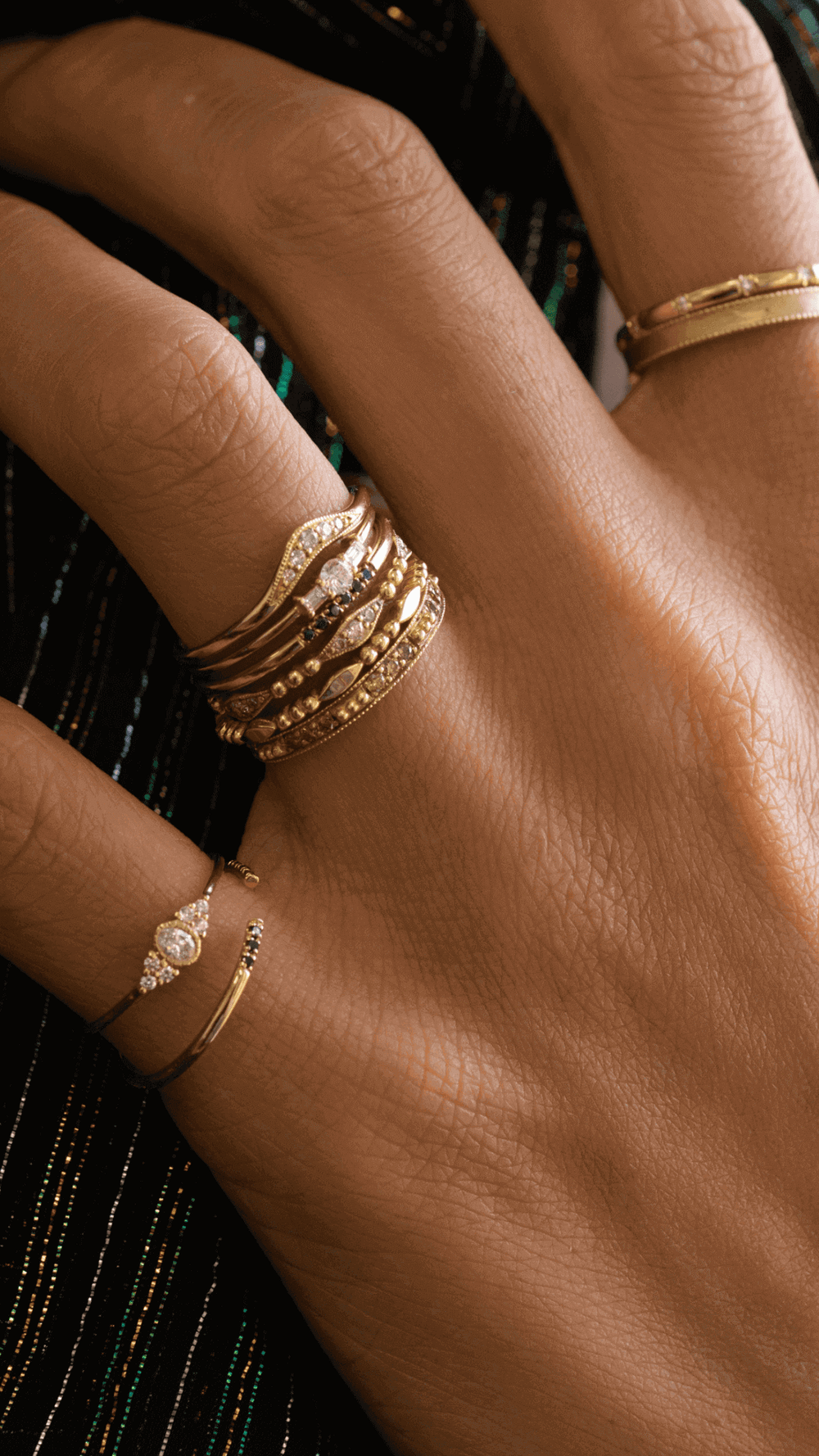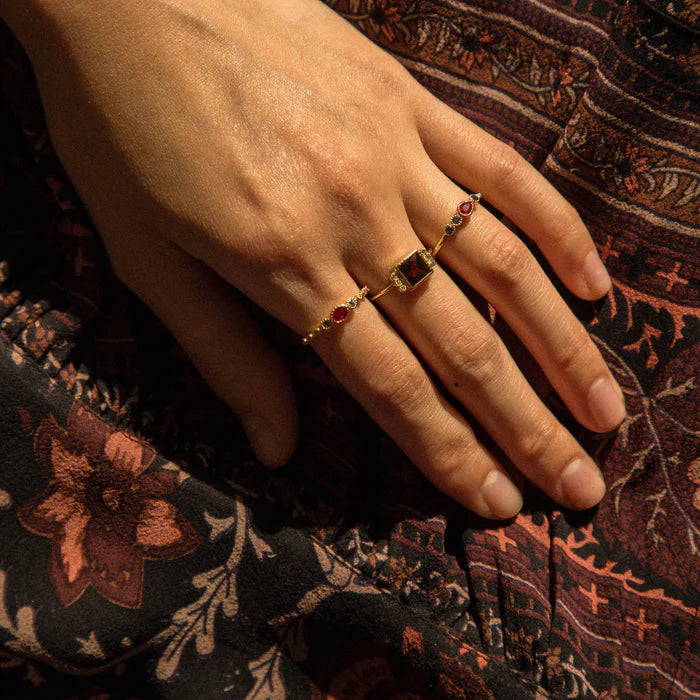In this article, we cover:
What is an Art Deco engagement ring?
What is Art Deco?
How to spot the Art Deco era in jewelry?
What are the characteristics of Art Deco jewelry?
How to choose diamond engagement rings?
How to shop by cut and shape?
How to shop by ring settings?

What is an Art Deco engagement ring?
Are you shopping for a timeless wedding band or engagement ring? Well, nothing says that better than vintage! The demand for vintage design has taken off these past few years - vintage clothing, antique jewelry, you name it!
Modern men and women are craving authentic pieces that tell a story and make a statement. Engagement rings are no exception. Many future brides are choosing Art Deco designs for the perfect blend of retro and unique beauty that stands the test of time.
What is Art Deco?
Art Deco was born in the 1920s and is a result of the unforgettable art display at the Paris World's Fair in 1925. In fact, "Art Deco" is the short-hand for the exhibition title: Internationale Exposition des Arts Décoratifs et Industriels Modernes, or International Exposition of Modern Industrial and Decorative Arts, in English.
The elements of the exhibition that are favored today can be seen across several industries, including architecture, cars, fashion, and especially jewelry. Between 1920 and 1935, no two pieces of jewelry were the same, and Art Deco pieces stood out in high contrast to the accepted accessories of years past. By combining art and wardrobe, women embraced the artistic expression that evolved into the fashionable and iconic style still used and recreated today.
The Art Deco movement was not only a time of cultural innovation but of technological advancement in jewelry. To create the signature mosaic-like modern pieces, unique gemstone cuts like baguettes, emerald cuts, kite cuts, and trapezoids emerged. The diamond engagement ring became a highly personalized piece.
How to Spot The Art Deco Era in Jewelry?
True antique Art Deco jewelry has been passed on for generations and evokes its own history and story. Today, the romance of the roaring 20s lives on, with antique-inspired jewelry remaining high in popularity among brides. The energy behind Art Deco jewelry is bold and intricate.
Colored gemstones and pearls were combined with white gold, platinum, diamonds, and yellow gold for a daring contrast. The Art Deco approach to style was loud compared to the Edwardian period's soft shapes and pastel colors. Art Deco embraced the vibrance of emeralds, rubies, sapphires, and onyx and took inspiration from Asian, African, Native American, and Egyptian artifacts and artwork to create Art Deco's signature geometric and symmetrical designs.
Authentic Art Deco and Art Deco-inspired jewelry have at least one, if not all, a specific set of characteristics. You can develop an eye for Art Deco and even design your own Art Deco-inspired piece by following these tips.
What Are The Characteristics of Art Deco Jewelry?
Antique Cut Diamonds:
Unique cut diamonds are popular in Art Deco jewelry. Baguettes, emerald cuts, kite cuts, trapezoids, asscher cuts, and rose cuts were prominent. These stones often have larger faceting, are less sparkly, and have a softer look. It's said that these diamonds were meant to be viewed in candlelight for romantic tones and optimal glow. Modern takes on Art Deco also include oval and round cut diamonds set in milgrain-style bezels alongside geometric elements.
Vibrant, Colorful, Geometric Design:
You'll know you've found Art Deco-inspired styles when you see bright, crisp lines and geometric shapes. Edwardian-era rings typically use smaller diamonds, while Art Deco features colored gems to accent patterns.
Platinum and White Gold:
At its birth, Art Deco jewelry was preferably created in platinum rather than yellow gold. White gold was born to battle the rising expenses of platinum and be a more accessible, affordable precious metal. Jennie Kwon offers white gold, yellow gold, and rose gold jewelry options for vintage-style engagement rings and beyond.
Milgrain Detail:
The Art Deco engagement rings of the 1920s produced crisp and precise milgrain work. Milgrain is a decorative technique used in the setting process where small beads of metal are used to create borders.
Bezel Setting:
The Art Deco innovation led to new engagement ring settings that arranged stones close together to create eye-catching gem mosaics. The Bezel setting has been less popular in the near past but is resurfacing in popularity with modern brides. The bezel is characterized by a ring of metal that holds the stone in place. Known as the oldest setting, it's tested, tried, and true to keep your fragile and precious stones safe with an encasing metal that slightly overlaps the stone.
How to Choose Diamond Engagement Rings?
Now that you can spot Art Deco style, it's time to consider whether you want to incorporate it into your ring set. Whether you're shopping for wedding bands or engagement rings, there are many authentic antique and Art Deco-inspired styles to choose from. Jennie Kwon Designs offers an entire collection of stunning Diamond Engagement Rings. Fortunately, there is a formula that jewelers use to uncover a diamond in the rough.The 4 C's of Diamonds:
Color:
Diamonds in the subtle variations and in white colorless diamonds are the most popular, but diamonds occur naturally in a wide variety of colors. The Gemological Institute of America (GIA) created a color scale beginning with the letter D and continuing through the English alphabet to Z. When you find a stone with a color higher than Z, they are called fancy-colored diamonds. These rare stones come in many different colors and color combinations. The grading of these rare color combo stones is based on color and color intensity.
If you're wanting to stay true to the Art Deco tones, check out our collection of Colored Gemstone Engagement Rings.
Cut:
Cut refers to the polished finish, symmetry, angles, and proportions of facet arrangements, and not to the shape of a diamond (old European, Asscher cut, etc.) The diamond's visual elements are informed by its cut - fire, brightness, and scintillation.
Antique diamonds can be found in many shapes and cuts. The emerald cut (originally created for the cutting of emeralds) is less common but rising in popularity. The pavilion and polishing style is designed to draw the eye to the table of the gem. If selecting this cut and shape it's important to choose a high-quality gem that will highlight its clarity. The emerald cut is a perfect choice for elegant and clear beauty rather than sparkly.
At Jennie Kwon Designs, we provide our customers with a variety of stone cuts like emerald cut, cushion cut, marquise, oval, pear, rose, and the classic round. Browse through our entire collection of engagement rings and beyond, and easily filter by cut.
Clarity:
Clarity describes the purity of the diamond. Due to the nature of how diamonds are formed under extreme pressure and heat, diamonds are at risk for internal inclusions and external blemishes. Very few diamonds are internally flawless, and we identify diamonds based on key characteristics. The GIA and the American Gem Society (AGS) identify and grade them based on these characteristics, specific to their size, nature, and location in or on the stone. These grades range from flawless to included, using the abbreviations IF for Internally Flawless / Flawless – meaning no internal or external imperfections.
Carat Weight:
Diamonds are measured by their "carat," referring to their weight, not their size. Carats are measured in fractions with 100 points to a carat. It's not uncommon for a diamond to appear smaller or larger than its actual carat weight. The way a diamond is shaped and the way in which it was set can change its appearance. Carat weight is important to the appearance and value of the stone but should not be the sole factor when choosing a diamond. When it comes to engagement rings, choose stones that fit the wearers' style.
How to Shop by Cut and Shape?
Jewelers often use the term shape and cut interchangeably when referring to stones, so it’s important to distinguish between the characteristics. The two main groups of stone shapes are round and fancy shape diamonds. When we refer to diamond shape, we're talking about the geometric characteristics of the stone. You'll commonly see the round or round brilliant shape because it's the most traditional and popular cut that most jewelers provide. Fancy shapes include the princess, pear, oval, heart, Marquise, and Trillion. Appearance, brilliance, and price vary per carat.
How to Shop by Ring Settings?
Choosing a stone and setting that works well together will determine the beauty and brilliance of a piece. Three well-known antique Art Deco-inspired ring settings are the solitaire, pavé, and bezel.
Solitaire ring: A timeless classic, a solitaire setting has just a single stone. The center diamond is secured with pressure, bezel, or prongs. Generally, solitaire rings are minimalistic. These days, solitaire refers to the setting and not the overall ring design. You can find solitaire rings that have a single center stone and have other stones on the shoulder in the band.
Our Diamond Solitaire Etude ring is thoughtfully designed to make it feel like they're floating on your hand.
Bezel setting: Categorized by full or partial, Bezel settings and can be used in the center stone or as accent diamonds along the band. A full bezel secures the stone with a thin metal rim. A partial bezel setting makes more of the stone visible and is only partially covered. The advantage of a bezel setting is that it can hide inclusions of a stone, is easier to clean, and will remain secure.
Our Emerald Wave Ring is bezel set and accented with six white diamonds paved along the band.

Where to Find Your Perfect Art Deco Ring?
If you’re looking for a special style that will take your bride’s breath away, consider the timeless classics of Art Deco. Keep in mind the shape of your diamond and how it will look and feel on your finger. A diamond is an investment for a lifetime, it should be comfortable and flattering on the hand.
If you’re looking for stunning Art Deco pieces, Jennie Kwon creates custom pieces that are handmade to order and offer ship-ready items. We work with reputable suppliers to ensure our gems are ethically and responsibly sourced.
Each bespoke piece is meticulously designed with unforgettable and unique accents meant to be graceful, balanced, and wearable. Antique-inspired rings are celebrated for their magnificence, superb design, and attention to detail. If you’re looking for a wedding band that is sophisticated and glamorous with a vintage charm, shop our Wedding Band Collection.
Sources:
https://www.americangemsociety.org/precious-metal-jewelry/
https://learningjewelry.com/guides/platinum-vs-white-gold/
https://vintagediamondring.com/blogs/list/everything-you-need-to-know-about-solitaire-engagement-rings-2022
https://www.langantiques.com/knowledge/about-antique-and-vintage-jewelry
https://www.naturallycolored.com/diamond-education/diamond-grading/diamond-color-chart


